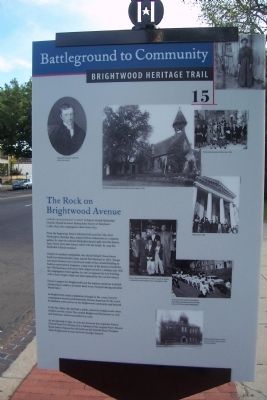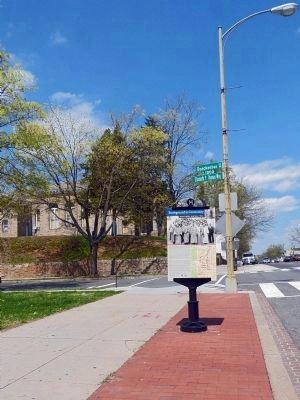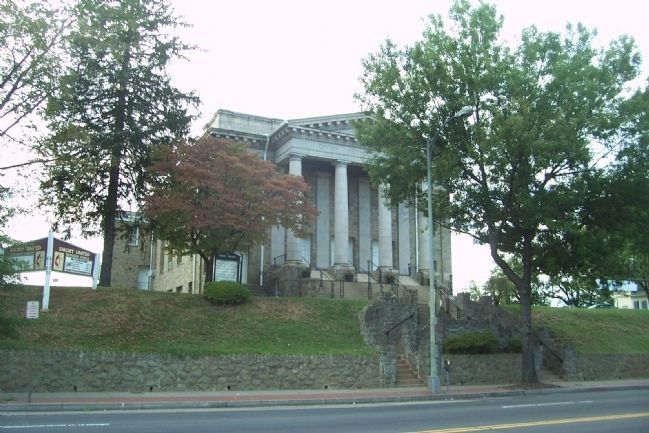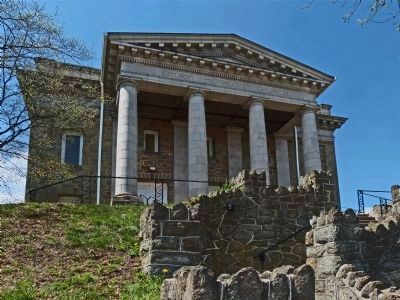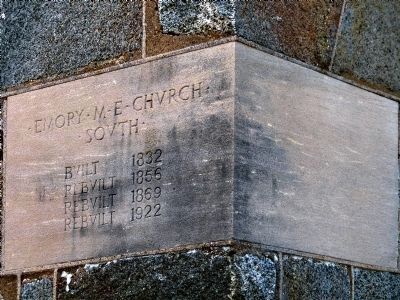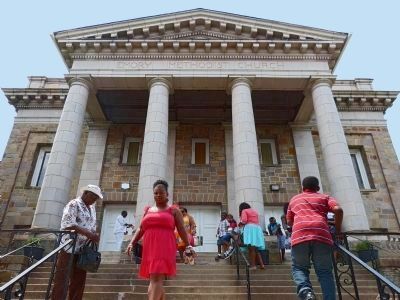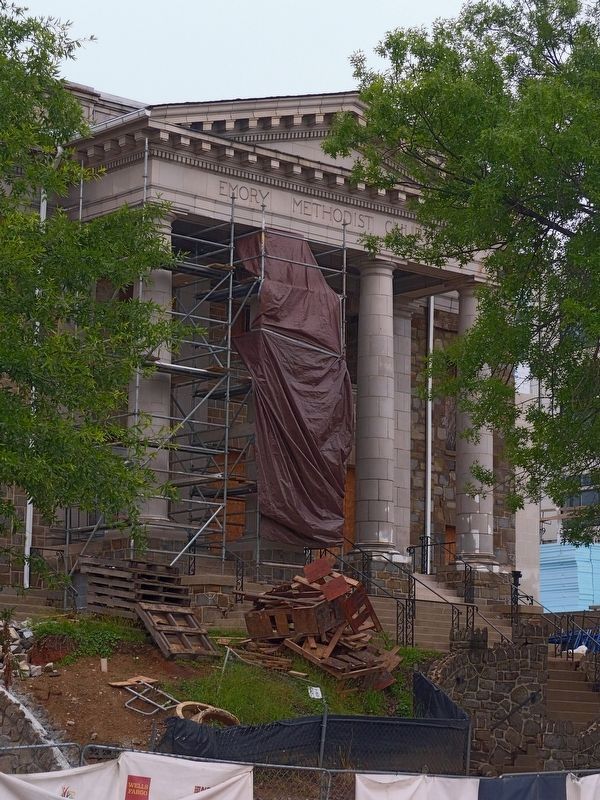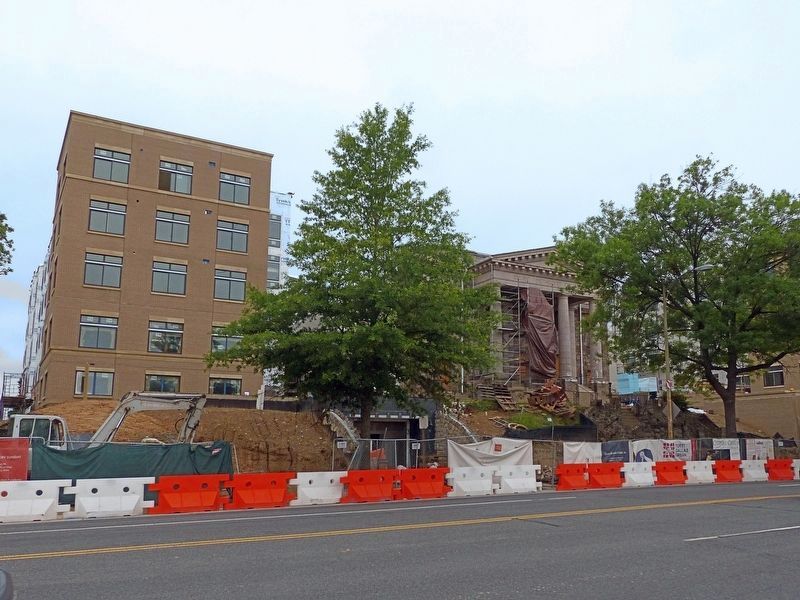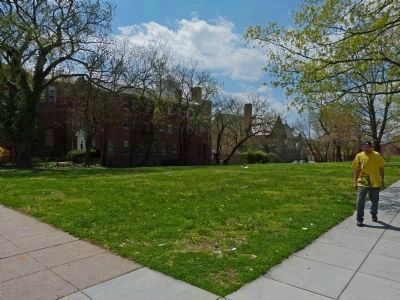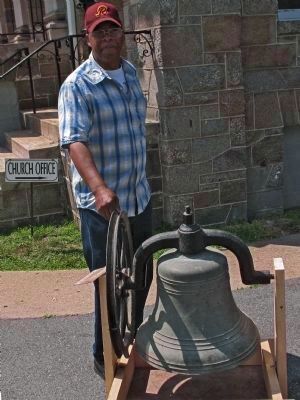Brightwood in Northwest Washington in Washington, District of Columbia — The American Northeast (Mid-Atlantic)
The Rock on Brightwood Avenue
Battleground to Community
— Brightwood Heritage Trail —
Across Quackenbos Street Emory United Methodist Church. Named to honor Bishop John Emory of Maryland (1789-1835), the congregation dates from 1832.
From the beginning, Emory welcomed all races but, like most Washington churches then, seated African Americans in a separate gallery. In 1846 the national Methodist church split over the slavery issue. Seven years later Emory sided with the South. In 1939 the Methodist Church reunited.
Despite its southern sympathies, the church had helped Union forces build Fort Massachusetts (later named Fort Stevens) in 1861. Troops tore down Emory’s new church to build an ammunition magazine, using some of the bricks to build the fort. Emory’s basement served as a military jail. In 1870 the congregation replaced the lost building with a stone chapel, which was later replaced by the current church.
Emory’s support for the nation’s needs has included ministering to soldiers at Walter Reed Army Hospital during and after World War I.
As Brightwood’s racial complexion changed in the 1950s, Emory’s congregation became predominantly African American by the 1970s.
In the late 1880s, the city built a public school for Brightwood’s White children on this corner. The current Brightwood Elementary at 13th and Nicholson streets succeeded it in 1925.
As you proceed to sign 16, note the driveway that separates Emory Church from Fort Stevens. It is a remnant of the original Piney Branch Road, built to bypass the toll booth on the Seventh Street Turnpike (later Brightwood Avenue and now Georgia Avenue).
Erected 2008 by Cultural Tourism DC. (Marker Number 15.)
Topics and series. This historical marker is listed in these topic lists: African Americans • Churches & Religion • Settlements & Settlers • War, US Civil. In addition, it is included in the Brightwood Heritage Trail series list. A significant historical year for this entry is 1832.
Location. This marker has been replaced by another marker nearby. It was located near 38° 57.821′ N, 77° 1.676′ W. Marker was in Northwest Washington in Washington, District of Columbia. It was in Brightwood. Marker was at the intersection of Georgia Avenue Northwest (U.S. 29) and Quackenbos Street Northwest, on the right when traveling south on Georgia Avenue Northwest. Touch for map. Marker was in this post office area: Washington DC 20011, United States of America. Touch for directions.
Other nearby markers. At least 8 other markers are within walking distance of this location. A different marker also named The Rock on Brightwood Avenue (here, next to this marker); “Get Down You Fool” (about 300 feet away, measured in a direct line); Fort Stevens (about 400 feet away); A Streetcar Named Brightwood (about 400 feet away); Scale Model of Fort Stevens (about 400 feet away); Lincoln Under Fire at Fort Stevens (about 500 feet away); a different marker also named Fort Stevens (about 500 feet away); Aunt Betty's Story (about 500 feet away). Touch for a list and map of all markers in Northwest Washington.
More about this marker. In the upper left is a portrait of Bishop John Emory, for whom the church was named. In the upper center is a photo of The third Emory Church, a stone chapel, was torn down in 1922. In the upper right is a photo of Mabel Gatley (women’s) Bible class, 1940.
Down the right side is a series of photos depicting life in the congregation. The first is captioned, After church, 1939. Beside it Emory Church Senior Pastor Dr. and Mrs. Joseph W. Daniels, Jr. pose with young members of the congregation, 2005. And another photo shows An Emory Church walk for the homeless steps off from behind the church on what was once the Piney Branch road bypass.
At the bottom right is a photo
of Brightwood Elementary School, the community’s second school for White children.
Related marker. Click here for another marker that is related to this marker. This marker has been replaced by the linked marker.
Additional keywords. Methodist Episcopal
Credits. This page was last revised on January 30, 2023. It was originally submitted on March 20, 2009, by Richard E. Miller of Oxon Hill, Maryland. This page has been viewed 2,313 times since then and 29 times this year. Last updated on June 17, 2018, by Allen C. Browne of Silver Spring, Maryland. Photos: 1. submitted on March 20, 2009, by Richard E. Miller of Oxon Hill, Maryland. 2. submitted on April 30, 2013, by Allen C. Browne of Silver Spring, Maryland. 3. submitted on March 20, 2009, by Richard E. Miller of Oxon Hill, Maryland. 4, 5. submitted on April 30, 2013, by Allen C. Browne of Silver Spring, Maryland. 6. submitted on May 1, 2013, by Allen C. Browne of Silver Spring, Maryland. 7, 8. submitted on June 17, 2018, by Allen C. Browne of Silver Spring, Maryland. 9. submitted on April 30, 2013, by Allen C. Browne of Silver Spring, Maryland. 10. submitted on May 2, 2013, by Allen C. Browne of Silver Spring, Maryland. • Andrew Ruppenstein was the editor who published this page.
